To stop lens fog and capture clear shots, you'll need to understand its causes and prevention methods. Sudden temperature changes and humidity are the main culprits. Quick fixes include using a microfiber cloth to wipe away condensation or applying anti-fog solutions. For long-term prevention, store your gear properly and gradually acclimate it to new environments. Essential tools like anti-fog sprays, microfiber cloths, and proper storage containers can make a big difference. Remember to clean your lenses regularly and consider professional maintenance for peak performance. By mastering these techniques, you'll be well-equipped to tackle lens fog in any shooting situation.
Understanding Camera Lens Condensation

If you've ever experienced lens fog, you know how frustrating it can be. This common issue occurs when your camera lens encounters a sudden temperature change, causing moisture in the air to condense on its surface.
It's particularly problematic when moving between warm and cold environments or in humid conditions.
Lens fog forms when warm, moist air meets a cooler surface. As your lens cools, it reaches the dew point—the temperature at which water vapor condenses into liquid. This creates tiny water droplets on the lens, obscuring your view and potentially ruining your shots.
Several factors contribute to lens condensation:
- Humidity: Higher moisture levels in the air increase fog risk.
- Temperature difference: Larger gaps between ambient and lens temperatures worsen condensation.
- Lens material: Some materials are more prone to fogging than others.
- Air circulation: Poor ventilation can trap moisture near your lens.
Understanding these factors helps you anticipate and prevent lens fog. By recognizing the conditions that lead to condensation, you'll be better equipped to protect your equipment and maintain clear, sharp images in challenging environments.
Common Causes of Foggy Lenses
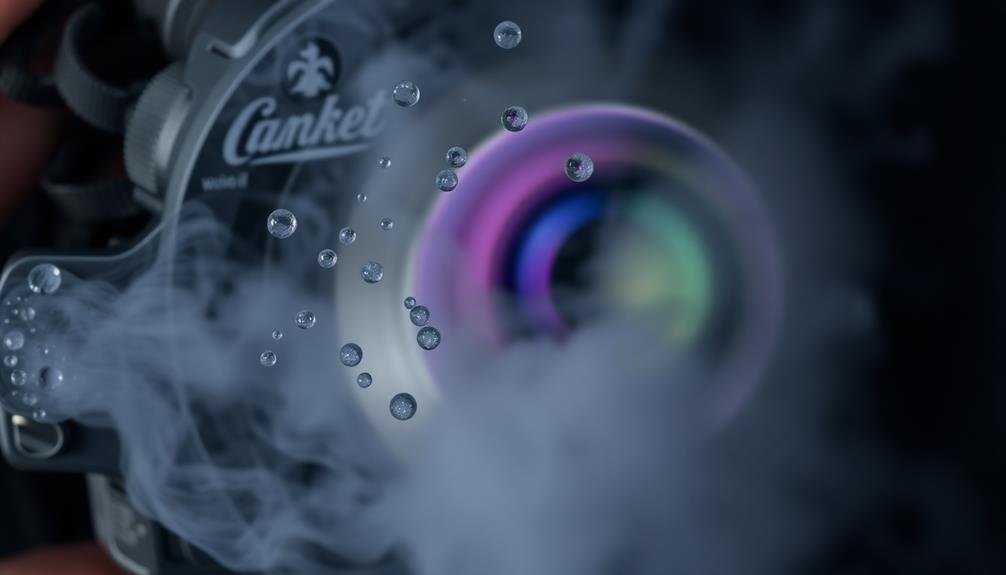
Frequently, photographers encounter foggy lenses due to a handful of common causes. Temperature differences between your camera and the environment are often the primary culprit. When you move from a cool air-conditioned space to a warm, humid outdoor setting, condensation forms on your lens as the cold glass meets warm air. This temperature shock can quickly fog up your equipment, hindering your ability to capture clear shots.
Another common cause is your own breath. If you're shooting in cold weather, simply exhaling near your camera can create a foggy lens. The moisture from your breath condenses on the cold glass, creating a frustrating haze.
Finally, rapid changes in humidity can lead to lens fog, especially when shooting near bodies of water or in tropical climates.
To combat these issues, consider these preventative measures:
- Allow your camera to acclimate to new environments gradually
- Use a lens hood or your hand to shield the lens from your breath
- Store your camera in a sealed bag with silica gel packets when not in use
Quick Fixes for Immediate Results
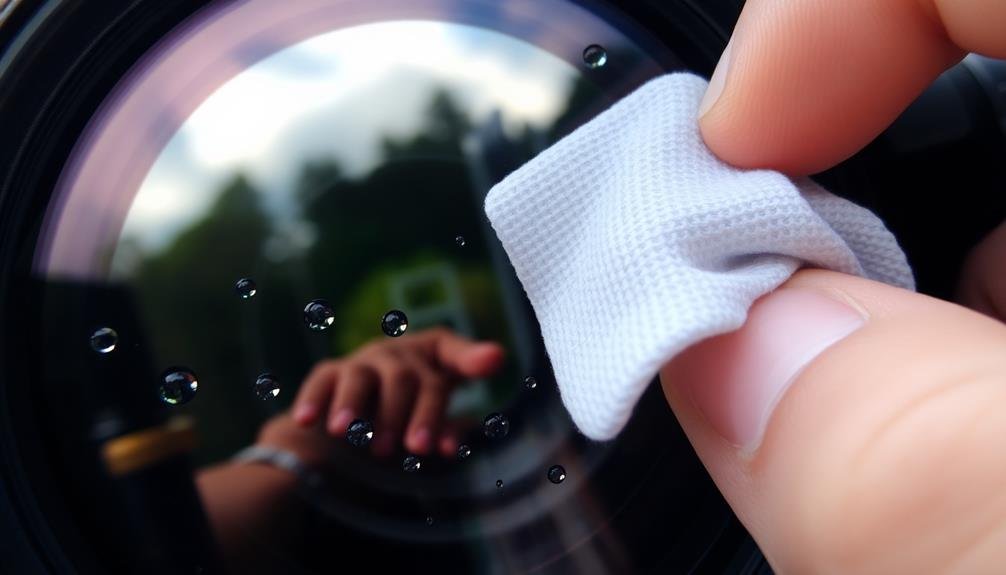
When lens fog strikes, you'll want quick solutions to get back to shooting. Try these immediate fixes to clear your lens and resume capturing those perfect shots:
- Use a microfiber cloth to gently wipe away condensation. This soft material won't scratch your lens and can quickly remove moisture.
- Blow warm air onto the lens using your breath. The heat will help evaporate the fog, but be careful not to add more moisture.
- Apply an anti-fog solution or spray designed for camera lenses. These products create a protective barrier against condensation.
- Move to a warmer area if possible. Temperature differences often cause fogging, so equalizing the environment can help.
- Use a lens hood to shield your glass from temperature changes and moisture.
Here's a quick reference guide for immediate fog-clearing techniques:
| Method | Effectiveness | Time | Equipment Needed |
|---|---|---|---|
| Microfiber cloth | High | Quick | Cloth |
| Warm breath | Medium | Quick | None |
| Anti-fog spray | High | Medium | Spray bottle |
| Change location | Medium | Slow | None |
| Lens hood | Medium | Instant | Hood |
Long-Term Prevention Strategies

To prevent lens fog in the long term, you'll want to explore more permanent solutions.
Start by applying an anti-fog coating to your lenses, which creates a protective barrier against moisture.
Additionally, store your eyewear properly in a dry, cool place and establish a regular cleaning routine to maintain peak lens performance.
Anti-Fog Coating Application
For long-term fog prevention, applying an anti-fog coating to your lenses can be a game-changer. These specialized coatings create a thin, transparent layer that prevents water droplets from forming on your lens surface.
You'll find various anti-fog products available, from sprays to wipes, each designed for different types of lenses and equipment.
Before applying an anti-fog coating, it's essential to clean your lenses thoroughly. Use a microfiber cloth and lens cleaner to remove any dirt, oils, or residue that might interfere with the coating's effectiveness.
Once clean, follow the product instructions carefully to apply the coating evenly.
Here's a quick guide to applying an anti-fog coating:
- Choose a well-ventilated area and lay out your equipment
- Apply the coating in thin, even layers, avoiding oversaturation
- Allow each layer to dry completely before adding another or using the lens
Remember that anti-fog coatings aren't permanent and may need reapplication periodically. The frequency depends on factors like usage, environmental conditions, and the specific product you've chosen.
With proper application and maintenance, you'll enjoy clearer shots and reduced frustration from foggy lenses.
Proper Storage Techniques
Proper lens storage is crucial for long-term fog prevention. To keep your lenses fog-free, store them in a cool, dry place away from direct sunlight and heat sources. Use airtight containers or camera bags with silica gel packets to absorb excess moisture.
Always clean your lenses before storage, removing any dirt, oils, or residue that could attract condensation.
When traveling, avoid rapid temperature changes by gradually acclimating your gear. Keep your camera equipment in insulated bags or cases to minimize temperature fluctuations. If you're moving from a cold to a warm environment, let your gear warm up slowly in its bag before use.
For long-term storage, consider using a dehumidifier cabinet or a dry box. These specialized storage solutions maintain ideal humidity levels, preventing moisture buildup that can lead to fog and fungus growth.
Regularly check and replace desiccants in your storage containers to guarantee continued effectiveness.
Don't forget to remove batteries from your camera during extended storage periods, as they can release corrosive gases that may damage your equipment.
Regular Cleaning Routine
While proper storage is key, maintaining a regular cleaning routine is equally important for long-term fog prevention. You'll want to establish a habit of cleaning your lenses after each use, especially if you've been shooting in humid or dusty environments.
Use a microfiber cloth to gently wipe away any smudges, fingerprints, or debris that may have accumulated on the lens surface.
For a more thorough cleaning, follow these steps:
- Use a blower brush to remove loose particles
- Apply a small amount of lens cleaning solution to a microfiber cloth
- Gently wipe the lens in a circular motion from the center outward
Don't forget to clean the lens caps and filters as well, as they can harbor moisture and dirt that may transfer to your lens.
It's also a good idea to periodically clean your camera body and other equipment to maintain overall hygiene and prevent fog-inducing contaminants from spreading.
Essential Cleaning Tools and Products
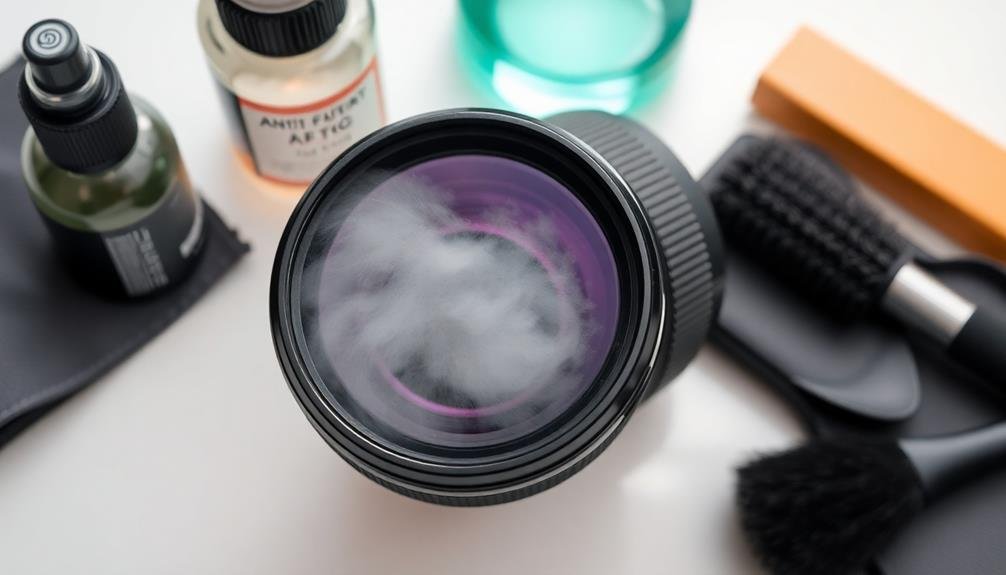
You'll need the right tools to keep your lenses fog-free.
Anti-fog sprays and wipes are essential for quick, on-the-go treatments, while microfiber cloths provide a gentle, scratch-free cleaning option.
Don't forget to store your lenses in microfiber pouches to protect them from dust and scratches when not in use.
Anti-Fog Sprays and Wipes
Anti-fog sprays and wipes are indispensable tools for keeping your lenses clear in challenging conditions. These products create a thin, transparent film on your lens surface that prevents moisture from condensing and forming droplets.
When you're shooting in humid environments or rapidly changing temperatures, they can make the difference between a crisp shot and a blurry mess.
To use anti-fog solutions effectively, follow these steps:
- Clean your lens thoroughly before applying any anti-fog product
- Apply the spray or wipe evenly across the lens surface
- Allow the solution to dry completely before using your camera
You'll find various brands and formulations on the market, each with its own strengths.
Some are designed for long-lasting protection, while others offer quick application for on-the-go use. It's worth experimenting with different options to find what works best for your needs and equipment.
Microfiber Cloths and Pouches
Beyond anti-fog solutions, microfiber cloths and pouches are indispensable tools for keeping your lenses clean and fog-free. These soft, lint-free materials are designed to remove smudges, dust, and moisture without scratching your valuable optics.
Use a microfiber cloth to gently wipe your lens before and after each shooting session, guaranteeing you've removed any debris that could contribute to fogging.
When you're not using your camera, store it in a microfiber pouch. These pouches not only protect your lens from scratches but also help absorb excess moisture that can lead to fogging. Choose a pouch with a drawstring closure to keep dust and humidity at bay.
For best results, carry multiple microfiber cloths in your camera bag. Use one for cleaning the lens surface and another for wiping away condensation.
Remember to wash your microfiber cloths regularly with mild soap and warm water, avoiding fabric softeners that can leave residue. Air-dry them completely before use.
When cleaning your lens, use gentle circular motions starting from the center and moving outward. This technique helps prevent streaks and guarantees thorough cleaning.
Environmental Factors Affecting Lens Clarity

Moisture, temperature, and air quality play essential roles in lens clarity. When you're shooting in various environments, these factors can greatly impact your camera's performance.
Humidity is often the main culprit behind lens fog, especially when moving between areas with drastic temperature differences. Cold lenses exposed to warm, moist air are particularly susceptible to condensation.
To combat these environmental challenges, consider the following:
- Acclimate your gear gradually when shifting between different temperatures.
- Use a lens hood to shield your glass from direct sunlight and reduce heat buildup.
- Invest in a quality UV filter to protect your lens from dust and pollutants.
Air pollution and dust particles can also compromise image quality by settling on your lens surface. In coastal areas, salt spray can be particularly damaging.
Always keep your lens cap on when not shooting, and clean your equipment regularly with appropriate tools. Be mindful of rapid weather changes, as they can catch you off guard and potentially ruin a shoot.
Proper Storage Techniques
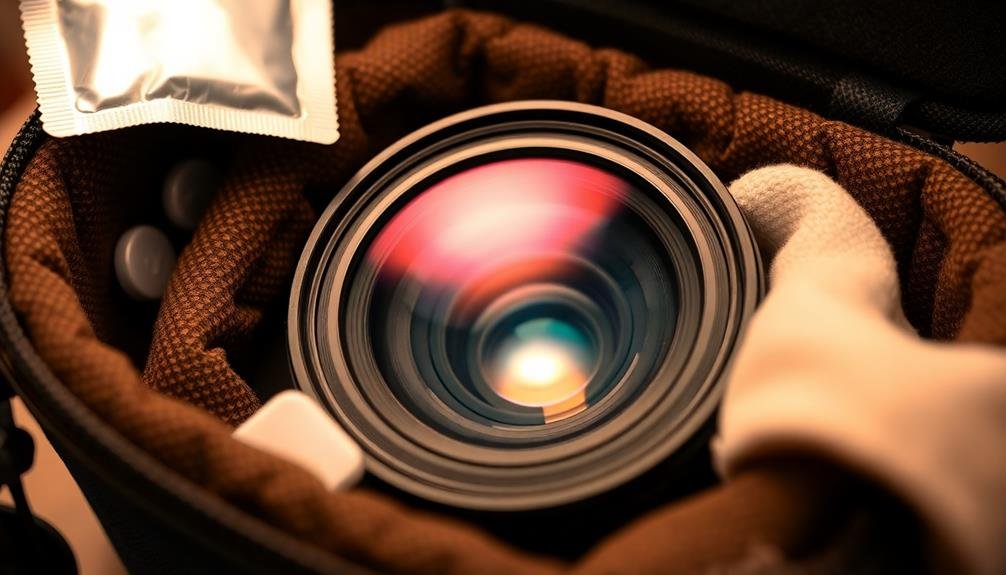
To maintain lens clarity and prevent fog, proper storage techniques are essential. When you're not using your camera, store it in a cool, dry place away from direct sunlight and humidity. Use a padded camera bag or case with silica gel packets to absorb moisture. Always cap your lenses and keep them in protective pouches.
Before storage, clean your lenses thoroughly with a microfiber cloth and lens cleaning solution. This removes any residue that could attract moisture. If you're storing your equipment for an extended period, consider using a dehumidifier in your storage area.
When shifting between different temperature environments, let your camera and lenses acclimate gradually. Place them in a sealed plastic bag before moving from cold to warm areas to prevent condensation. Don't rush to use your gear immediately after such shifts.
For long-term storage, remove batteries from your camera to prevent corrosion. If you're storing lenses separately, use lens cases with airtight seals.
Regularly check your stored equipment for signs of mold or fungus, which thrive in damp conditions. By following these storage techniques, you'll greatly reduce the risk of lens fog and maintain your gear's best performance.
Professional Maintenance Tips
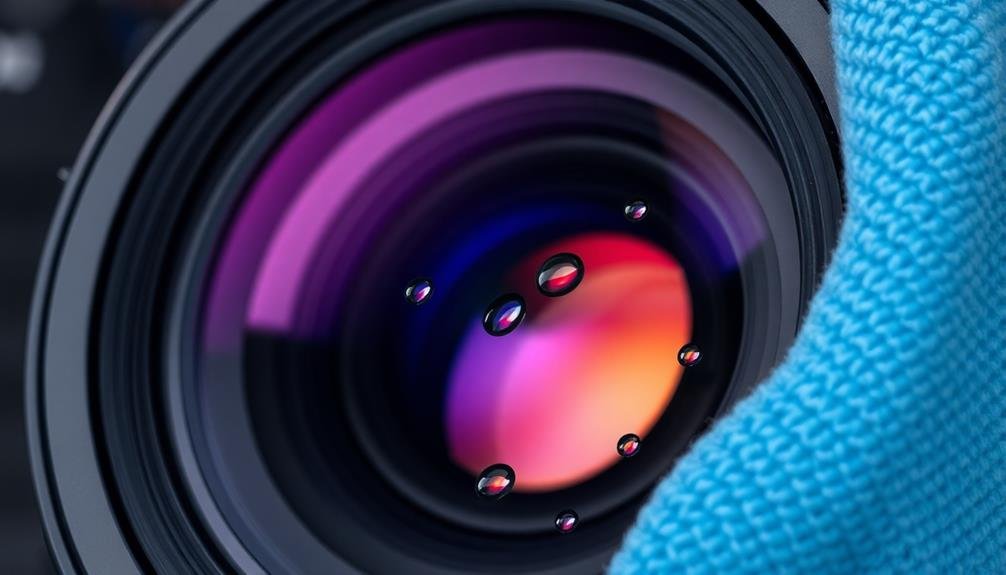
While proper storage and regular cleaning are essential, there's no substitute for professional maintenance when it comes to keeping your lenses fog-free.
Consider scheduling annual check-ups with a certified camera technician to guarantee your equipment remains in top condition. They'll inspect your lenses for any microscopic damage, worn seals, or alignment issues that could contribute to fogging.
During these professional maintenance sessions, you can expect:
- Thorough cleaning of lens elements using specialized equipment
- Inspection and replacement of worn weather sealing
- Calibration of autofocus and image stabilization systems
Don't hesitate to ask your technician for advice on preventing lens fog specific to your gear and shooting conditions.
They may recommend additional protective coatings or suggest upgrades to your current equipment for improved performance in challenging environments.
DIY Anti-Fog Solutions
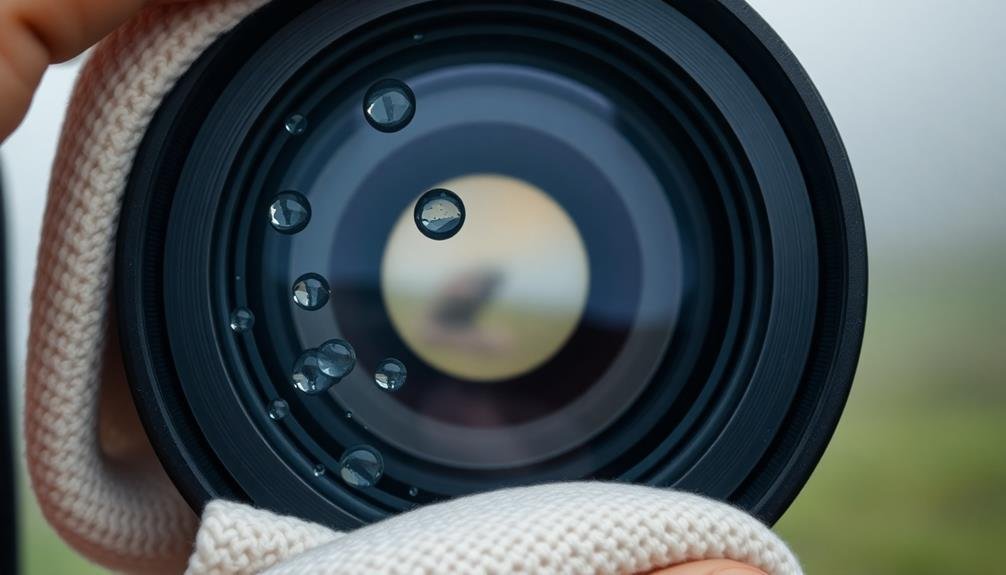
Photographers on a budget or in a pinch can turn to several do-it-yourself solutions to combat lens fog. One of the simplest methods is to use a mixture of water and white vinegar. Mix equal parts in a spray bottle and apply it to your lens, wiping it off with a microfiber cloth. This creates a thin, invisible layer that helps prevent condensation.
Another effective DIY solution is using glycerin or dish soap. Rub a small amount onto your lens and buff it off with a clean cloth. These substances create a hydrophobic barrier, causing water droplets to bead up and roll off instead of forming fog.
You can also try the old scuba diver's trick of using saliva. While it may sound unpleasant, a thin layer of saliva can prevent fogging for a short period. Just remember to clean your lens thoroughly afterward.
For a longer-lasting solution, consider making your own anti-fog spray. Mix one part glycerin with two parts water and a drop of dish soap. Store this in a small spray bottle for quick application when needed.
These DIY methods can be lifesavers when you're caught without commercial anti-fog products.
Frequently Asked Questions
Can Lens Fog Damage My Camera's Internal Components?
You don't need to worry about lens fog damaging your camera's internal components. It's typically harmless and doesn't penetrate the lens. However, it can affect image quality, so it's best to prevent or remove fog when shooting.
Does Lens Coating Affect How Easily a Lens Fogs Up?
Yes, lens coating can affect fogging. If you've got a lens with anti-fog coating, it'll resist moisture buildup better. However, even coated lenses can fog up in extreme conditions, so it's not a foolproof solution.
Are There Specific Camera Models More Prone to Lens Fogging?
You'll find that camera models aren't inherently more prone to fogging. It's more about the environment you're shooting in and how quickly you shift between temperature extremes. Any camera can fog up under certain conditions.
How Does Altitude Affect Lens Fogging During Outdoor Photography?
As you climb higher, you'll face increased lens fogging risks. Thinner air and lower temperatures at altitude create ideal conditions for condensation. You'll need to take extra precautions to keep your lens clear during high-elevation photo shoots.
Can Using a UV Filter Help Prevent Lens Fog?
While a UV filter won't directly prevent lens fog, it can offer some protection. You'll still need to address temperature differences causing condensation. Consider using anti-fog solutions or warming your lens to combat fogging more effectively.
In Summary
You've now got the tools to combat lens fog and keep your shots crystal clear. Remember, prevention is key, so store your gear properly and be mindful of temperature changes. When fog strikes, act fast with quick fixes, but don't forget long-term strategies. With these tips, you'll be ready to tackle any condensation challenge. Keep your cleaning kit handy, stay aware of your environment, and you'll always be prepared for that perfect shot.


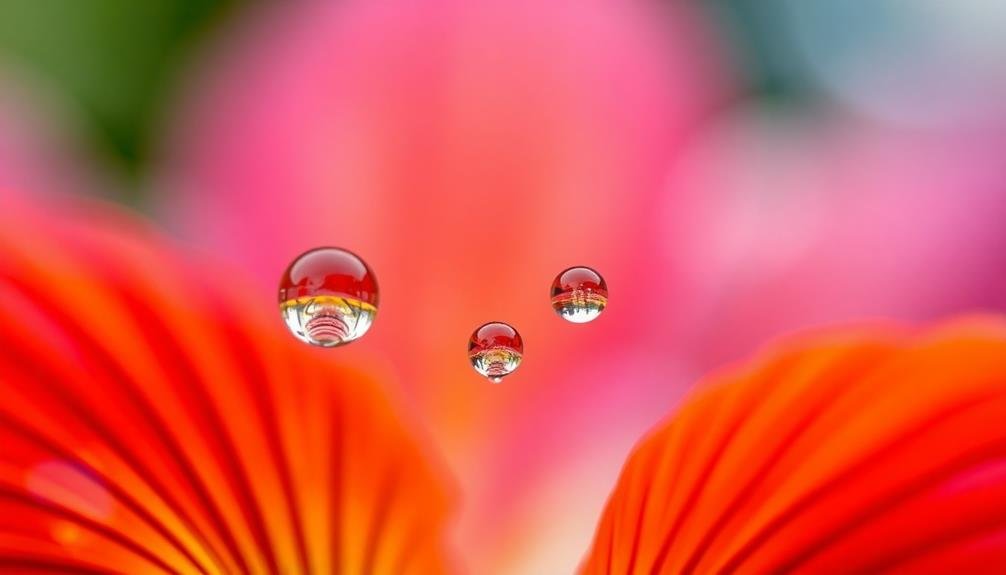
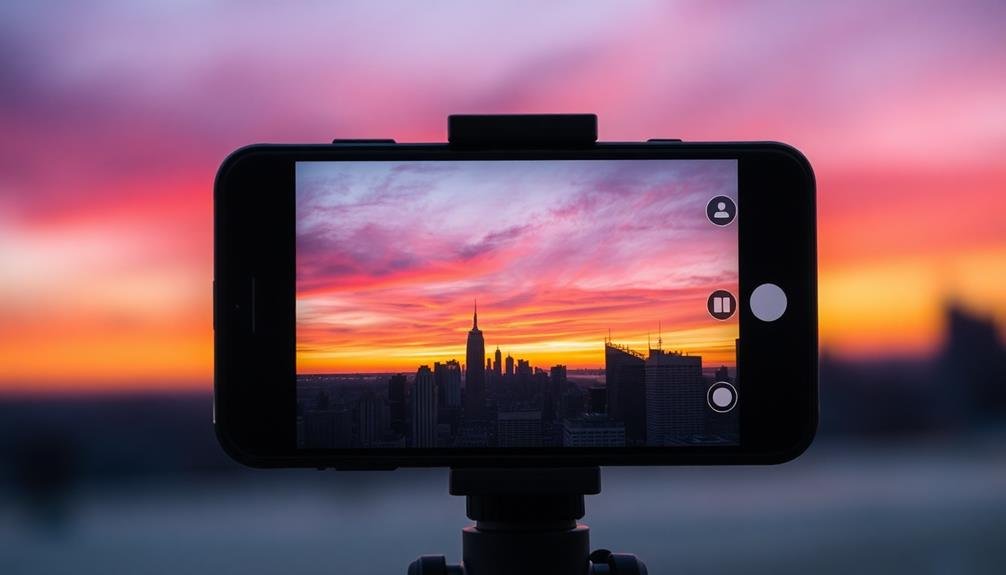

Leave a Reply